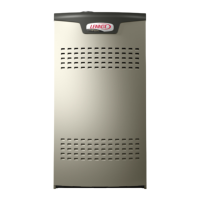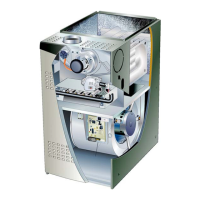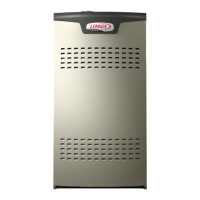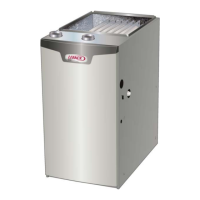Page 5
General
These instructions are intended as a general guide and do
not supersede local codes in any way. Consult authorities
having jurisdiction before installation.
In addition to the requirements outlined previously, the
following general recommendations must be considered
when installing a EL180UHNE furnace:
• Place the furnace as close to the center of the air
distribution system as possible. The furnace should
also be located close to the chimney or vent termi-
nation point.
• Do not install the furnace where drafts might blow
directly into it. This could cause improper combus-
tion and unsafe operation.
• Do not block the furnace combustion air openings
with clothing, boxes, doors, etc. Air is needed for
proper combustion and safe unit operation.
• When the furnace is installed in an attic or other
insulated space, keep insulation away from the fur-
nace.
• Please consult the manufacturer of your evaporator
coil for their recommendations on distance required
between the heat exchanger and their drain pan.
Adequate space must be provided between the
drain pan and the furnace heat exchanger.
Combustion, Dilution & Ventilation Air
In the past, there was no problem in bringing in sucient
outdoor air for combustion. Inltration provided all the air
that was needed. In today’s homes, tight construction
practices make it necessary to bring in air from outside for
combustion.
Take into account that exhaust fans, appliance vents,
chimneys, and replaces force additional air that could be
used for combustion out of the house. Unless outside air
is brought into the house for combustion, negative pres-
sure (outside pressure is greater than inside pressure) will
build to the point that a downdraft can occur in the furnace
vent pipe or chimney. As a result, combustion gases enter
the living space creating a potentially dangerous situation.
In the absence of local codes concerning air for combus-
tion and ventilation, use the guidelines and procedures in
this section to install EL180UHNE furnaces to ensure ef-
cient and safe operation. You must consider combustion
air needs and requirements for exhaust vents. A portion of
this information has been reprinted with permission from
the
National Fuel Gas Code (ANSI-Z223.1). This reprinted
material is not the complete and ocial position of the
ANSI on the referenced subject, which is represented only
by the standard in its entiret
CAUTION
Do not install the furnace in a corrosive or contaminated
atmosphere. Meet all combustion and ventilation air
requirements, as well as all local codes.
CAUTION
Insucient combustion air can cause headaches,
nausea, dizziness or asphyxiation. It will also cause
excess water in the heat exchanger resulting in rusting
and premature heat exchanger failure. Excessive
exposure to contaminated combustion air will result
in safety and performance related problems. Avoid
exposure to the following substances in the combustion
air supply:
Permanent wave solutions
Chlorinated waxes and cleaners
Chlorine base swimming pool chemicals
Water softening chemicals
De-icing salts or chemicals
Carbon tetrachloride
Halogen type refrigerants
Cleaning solvents (such as perchloroethylene)
Printing inks, paint removers, varnishes, etc.
Hydrochloric acid
Cements and glues
Antistatic fabric softeners for clothes dryers
Masonry acid washing materials
All gas-red appliances require air for the combustion
process. If sucient combustion air is not available, the
furnace or other appliances will operate ineciently and
unsafely. Enough air must be provided to meet the needs
of all fuel-burning appliances and appliances such as ex-
haust fans which force air out of the house. When re-
places, exhaust fans, or clothes dryers are used at the
same time as the furnace, much more air is necessary
to ensure proper combustion and to prevent a downdraft.
Insucient air causes incomplete combustion which can
result in carbon monoxide.
In addition to providing combustion air, fresh outdoor air
dilutes contaminants in the indoor air. These contaminants
may include bleaches, adhesives, detergents, solvents
and other contaminants which can corrode furnace com-
ponents.
The requirements for providing air for combustion and
ventilation depend largely on whether the furnace is in-
stalled in an unconned or a conned space.
Unconned Space
An unconned space is an area such as a basement or
large equipment room with a volume greater than 50 cubic
feet (1.42 m3) per 1,000 Btu (.29 kW) per hour of the com-
bined input rating of all appliances installed in that space.
This space also includes adjacent rooms which are not
separated by a door.

